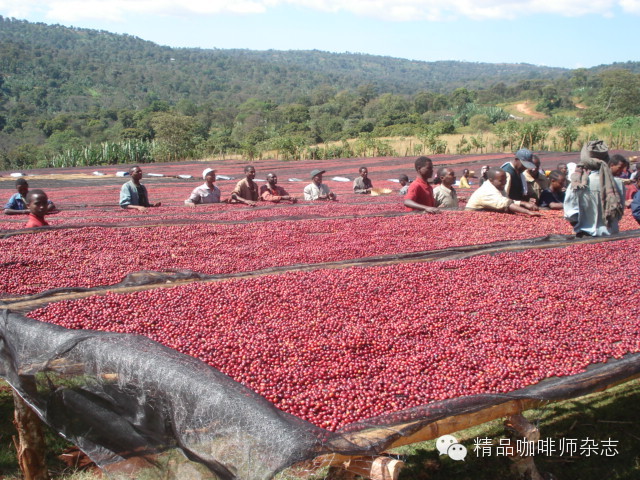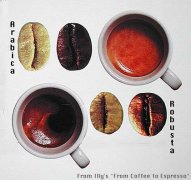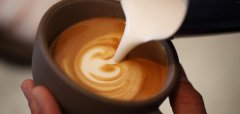The discrimination of gourmet coffee beans the quality of coffee Arabica coffee tree
The quality of coffee

I. selection and purchase of coffee beans
1. Steps to buy coffee beans
Freshness is the life of coffee. There are three steps to determine the freshness of coffee beans: smell, see, and peel.
(1) smell
Put the coffee beans close to the nose and take a deep breath to see if you can clearly smell the aroma of the coffee beans. If so, it means the coffee beans are fresh enough. On the contrary, if the aroma is weak, or if the smell has begun to appear greasy (such as peanuts or nuts will appear for a long time), the coffee beans are not fresh at all. No matter how much effort you put into grinding and cooking such coffee beans, it is impossible to make a good cup of coffee.
(2) look
Spread out the coffee beans on your hands, determine the origin and variety of coffee beans, and make sure that the coffee beans are roasted evenly.
(3) peeling
Take a coffee bean and try to peel it off by hand. if the coffee bean is fresh enough, it should be easy to pull away, and it will have a crisp sound and feeling. If the coffee beans are not fresh, you will find that you have to work hard to get rid of a bean.
Peeling off the coffee beans also shows whether the firepower is uniform when baking. If it is uniform, the outer skin and inner layer of the beans should be the same color. If the color of the surface layer is obviously much darker than that of the inner layer, it means that there may be too much firepower during baking, which will also affect the aroma and flavor of coffee beans.
2. Matters needing attention in buying coffee beans
When you start to buy coffee beans, first choose a coffee shop where business is booming. The freshness of roasted beans is the life of coffee, so the warehouse where you choose to put fresh coffee beans should be cleaned, there is no residue of old beans, the sun will not shine directly, and there are no hot shops around.
When buying rear care shop grinding, be sure to inform the manager of the coffee making utensils used to match those props grinding (such as electric coffee maker, filter, paper, siphon, etc.).
When buying canned coffee powder in the supermarket, choose the label (the type of beans or the tendency to taste, etc.), depending on what you like.
3. Discrimination of gourmet coffee
At present, many coffee products are called gourmet coffee. The halo of this title has attracted many coffee fans to buy it. But what kind of coffee can be called gourmet coffee?
Gourmet coffee covers a wide range of areas, and what it has in common is that it can make an extremely delicious cup of coffee. Farming methods, origin, planting altitude, soil conditions and climatic conditions all play a vital role in whether coffee beans can become gourmet coffee. Like different kinds of fine wines, gourmet coffee is also divided into different ripening times, different countries and different regions. However, gourmet coffee has a unified feature, that is, it is made from the best coffee beans in the top coffee country of origin. It has the strictest production process to ensure its highest quality. Gourmet coffee beans are carefully hand-selected, processed and classified in the countries where they are grown. After that, the coffee beans are roasted with high quality in their exporting countries. Switzerland, for example, does not produce coffee beans, but its roasting technology is among the best in the world. Finally, after a sophisticated production process, coffee fans can taste the gourmet coffee.
Gourmet coffee is often called professional coffee, and the more common varieties include the Blue Mountains of Jamaica, Puerto Rico, Royal Crystal and Colombia. In addition, it can also add some excipients to make coffee drinks with different flavors. It is worth noting that flavored coffee refers to the addition of seasoning to hot coffee beans so that they can be quickly absorbed after roasting.
Gourmet coffee comes from the best Arabica beans. Arabica coffee tree is one of the most commonly grown coffee trees in the world. However, not all Arabica coffee is gourmet coffee. Moreover, the special growth conditions of Arabica coffee trees will determine whether they can become gourmet coffee. Therefore, when purchasing, we should know more about and test all aspects of it in order to ensure the quality.
As coffee fans know, Arabica coffee trees grow well at high elevations. Gourmet coffee usually comes from coffee trees that grow about 900 meters above sea level and lie between the Tropic of Cancer and the tropics or subtropics. The taller Arabica coffee trees grow, the more likely they are to produce gourmet coffee beans. The higher the density of coffee beans, the better their quality. Altitude is also directly related to coffee density. The higher the altitude, the higher the coffee density. As a result, Arabica coffee trees at high altitudes are more likely to produce gourmet coffee.
Although special external conditions can help it become a gourmet coffee, it is not the only condition. What is more important is its growth. As coffee trade becomes more and more important to many countries, the process of coffee cultivation has changed greatly. The traditional way to grow coffee is to plant it in the shade of trees. Nowadays, many growers grow coffee in the wilderness. This change increased the output of coffee beans and reduced the cost, but it had a great negative impact on its quality. Therefore, most gourmet coffee is organic coffee.
Organic coffee is made of beans grown in the shade of trees. Although the yield of the method of planting in the shade is not high, its quality can reach the level of gourmet coffee. This is because shading trees can slow down the ripening of coffee beans and give them full growth, making them contain more natural sugar, better taste and less caffeine. In addition, organic coffee does not use pesticides or other chemicals that affect the taste of coffee.
However, special growth conditions are not the only factor determining whether it is gourmet coffee or not. Another factor is precise mixing. When Arabica coffee beans are grown organically in excellent conditions, gourmet coffee is generally produced. However, in the coffee market, many coffee companies mix high-quality Arabica coffee beans with inferior coffee beans to reduce the quality of coffee in order to seek high profits. The content of Roberts beans in some mixed coffee is higher than that of Arabica coffee beans, resulting in a decline in the taste of coffee and an increase in caffeine levels. There are also some mixtures of Robster and Arabica of good quality, especially high-quality Italian roasted coffee. Of course, gourmet coffee is usually pure expensive Arabica coffee.
Gourmet coffee
Another element is baking. The roasting process will affect the taste of coffee, and there are no standard rules to follow. Moreover, the degree of baking depends on the country of origin and the characteristics of the coffee beans. Therefore, one kind of coffee bean should be roasted light brown to release its unique fragrance, and if another kind of coffee bean is made in the same way, it may be abusive. When you buy gourmet coffee, it is beneficial to consult a coffee expert about the unique roasting method of coffee.
The last thing coffee fans need to pay attention to is the smell of gourmet coffee. When the unique aroma of coffee is baked out, it is also the process of oxidation. When coffee beans are roasted, unstable oils will be easily oxidized and damage the quality of coffee. It is highly recommended to buy gourmet coffee in antioxidant bags or unground gourmet coffee beans.
Important Notice :
前街咖啡 FrontStreet Coffee has moved to new addredd:
FrontStreet Coffee Address: 315,Donghua East Road,GuangZhou
Tel:020 38364473
- Prev

Knowledge of espresso Italian blending of coffee beans Brazilian coffee strong Asian flavor
The word Espresso comes from Italian, meaning to brew it quickly for you, because espresso is delivered to the customer as soon as it is ready. Double espresso is made from 47 to 62.5 milliliters (1.5 to 2 ounces) of coffee extract, 88 to 95 degrees Celsius of pure water and 9 to 10 atmospheres in 22 to 28 seconds. The coffee extract is from 14 to 1.
- Next

Coffee milk foam hand-measured temperature the most suitable temperature for milk foam Italian style coffee with beans
The quality of milk foam affects the flavor of a cup of coffee to a great extent, and the temperature of milk foam is also a key factor affecting the quality of milk foam. This article will share with friends the manual temperature measurement skills of coffee milking and foaming. 1. The most suitable temperature for milk foam when milk foams on the coffee machine, the suitable temperature yesterday was controlled in the range of 60 ~ 70 degrees. The reasons are: 1. Milk
Related
- Beginners will see the "Coffee pull flower" guide!
- What is the difference between ice blog purified milk and ordinary milk coffee?
- Why is the Philippines the largest producer of crops in Liberia?
- For coffee extraction, should the fine powder be retained?
- How does extracted espresso fill pressed powder? How much strength does it take to press the powder?
- How to make jasmine cold extract coffee? Is the jasmine + latte good?
- Will this little toy really make the coffee taste better? How does Lily Drip affect coffee extraction?
- Will the action of slapping the filter cup also affect coffee extraction?
- What's the difference between powder-to-water ratio and powder-to-liquid ratio?
- What is the Ethiopian local species? What does it have to do with Heirloom native species?

